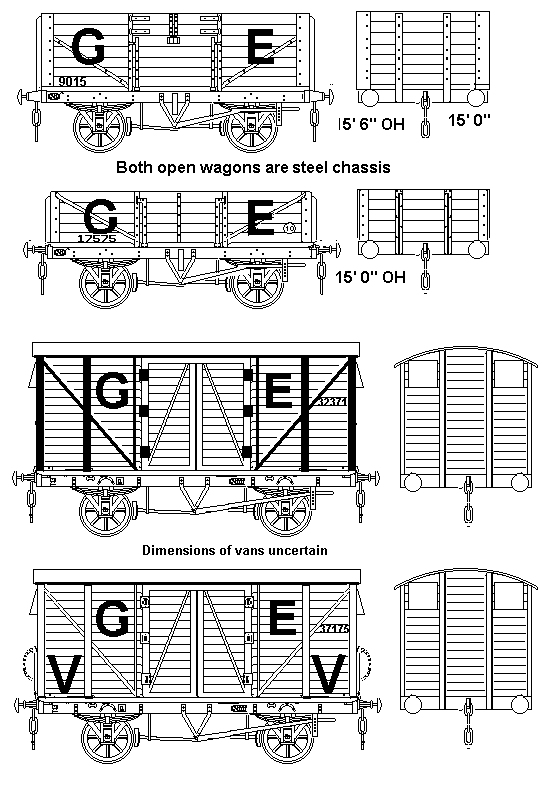
Great Eastern Railway
(Note: Numbers in brackets refer to specific references)
The Eastern Counties Railway opened in 1839 and over the years it bought out or established joint working arrangements with a number of lines. The closely allied Eastern Counties, Eastern Union, East Anglian, East Suffolk & Norfolk Railway with a number of minor lines were unified as the Great Eastern Railway in 1862. The GER linked London Liverpool Street station with Essex, Suffolk, Norfolk and Cambridgeshire and operated a virtual monopoly on rail transport within its East Anglian boundaries. The competition on its home territory came from the Midland & Great Northern Joint Railway and the smaller, but very profitable, London, Tilbury & Southend Railway (absorbed by the Midland Railway in 1912). Its London termini included Liverpool Street Station (1874) as well as the older stations at Shoreditch and Bishopsgate.
The GER ran very intensive suburban services in the London area and closely followed the Midland Railway in providing third class coaches on all trains. About the turn of the century, to compete with the new electric trams, they redeveloped their suburban services, the first and second class coaches bore distinctive blue and yellow striped livery. These 'jazz trains' as they were commonly known carried more passengers in the rush hour than any other railway in the country. The competition from the trams, and concerns over the cost of electrification, lead the GE to produce an 0-10-0 tank engine, given the number 10 and called the Decapod, designed to prove that steam could achieve the same acceleration as electric traction. The engine was, apparently, a success but it consumed a prodigious amount of fuel and only the one example was built. They also pioneered the use of oil as fuel for steam engines in the 1880's.
The Great Eastern served five important ports; Harwich, Felixstowe and Kings Lynn and the two major fishing ports of Lowestoft, Yarmouth. Ferry services to Holland operated from Harwich and when this port became overcrowded the GER built an extension to Parkeston Quay (named after the GER's chairman C.H.Parkes). Harwich was also an important naval port and during the First World War Parkston Quay became almost exclusively a naval base. Services to Holland saw an early use of containers in the form of outside framed wooden boxes used for passengers luggage. These were painted grey with the company initials on the sides but to date I have not been able to identify the wagons used to transport them. Train ferry services to the matching purpose built port in the Hook of Holland continued in operation until the opening of the channel tunnel.
Fish traffic was mainly carried to London and the Midlands. The fishing ports provided additional passenger traffic as they became popular resorts and summer services to other resorts such as Clacton. The GER went into partnership with the Great Northern to build a joint line from Doncaster to carry Yorkshire coal into East Anglia and through to London, a venture which proved very profitable to both companies.
Its many branch lines in the area to the east of Cambridge carried mainly agricultural traffic.
East Anglia is home to several of the larger agricultural equipment manufacturers and such equipment was regular cargo for the railway, carried on open wagons. Sugar beet, a notable crop in this part of the world, was hardly farmed at all until 1924.
The GER was at the forefront of steel underframe design, by 1900 over half the GER wagons and vans had steel underframes.
Goods stock was painted dark grey with white lettering and black underframes Initials used were G E in a plain lettering about eighteen inches high. On some vehicles the ironwork was picked out in black, example of this include the two open wagons and the unfitted van in the Sketch XXX. Vacuum fitted vans were painted distinctive a cream colour, with black lettering to the standard pattern but with large letter V's on each side of the doors as shown in the drawing.
The passenger stock was originally varnished teak, similar to the Graham Farish LNER coaches with pale yellow lettering shaded black and the underframes were black. Non passenger coaching stock had body ironwork picked out in black. After the First World War the GE changed to a crimson lake body colour but I cannot confirm how this compares to the Midland Railway colour.
Fig ___ GER

References:
(1) A Pictorial Record of LNER Wagons by Peter Tatlow - OPC - 1976 - ISBN 0 92888 92 7 Contains a few photographs of GER wagons.
(2) Freight Wagons and Loads in Service on the GWR and BR (WR) - J. H. Russell - OPC - 1981 - ISBN 86093 155 2 Contains a couple of photographs of GER wagons, notable one loaded with rectangular bales of hay.
(3) The life and Times of the Great Eastern Railway by Harry Paar and Adrian Gray - Castlemead Publications - 1991. Unseen - Reviews state it is a collection of stories about the line with plenty of illustrations.
Societies:
Available Models
Graham Hughes Kits 20, MacKelvie Road, Lamlash, Isle of Arran Strathclyde KA27 8NP
Mr. Hughes offers a white metal kit of the GER seven plank open wagon As with all Mr Hughes' kits the chassis is also supplied as part of the moulding.
Acknowledgements